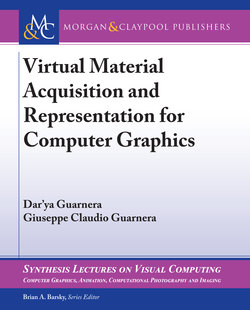Читать книгу Virtual Material Acquisition and Representation for Computer Graphics - Dar'ya Guarnera - Страница 8
На сайте Литреса книга снята с продажи.
ОглавлениеPreface
The quest for photorealism drives research toward new developments in Computer Graphics and related fields, with the aim of finally conquering the uncanny valley and making the virtual world indistinguishable from the real one. Achieving a photorealistic virtual representation of the real-world involves several factors, among which is a faithful reproduction of material appearance. Human perception of the appearance of an object depends on the way its surface reflects the incident light, since the reflection provides important visual cues about material properties, such as glossiness and color, used to identify the type of material (plastic, metal, rubber, ceramic, fabric, etc.) and additional information, for instance dry/wet or smooth/rough textures. Visual properties are related to physical characteristics like the diffuse and specular albedo, the index of refraction of the material (as well as that of the physical media in which it is placed, such as air or water), its surface roughness, and so on. The interaction between an opaque, homogeneous surface and the lighting incident on it can be described by the radiometric Bidirectional Reflection Distribution Function (BRDF). A huge body of computer graphics research has been carried out in order to derive compact and accurate models for BRDFs.
Selecting a suitable reflectance model to render a virtual material is not a straightforward task, since each reflectance model often aims to represent specific (subsets of) properties, with the result that a given model can describe plastic very well but not metals, and so on. Not all the BRDF models have become widespread in software packages, and the most common ones can be implemented differently in different renderers, leading to a slightly different rendered image. Hence, in this book we will focus on the theory rather than in the implementation. The reader will find accurate information about BRDF models, their taxonomy and characteristics, and the setup used to acquire the BRDF data, which range from low-to-high cost and low-to-high accuracy.
Dar’ya Guarnera and Giuseppe Claudio Guarnera
December 2017
